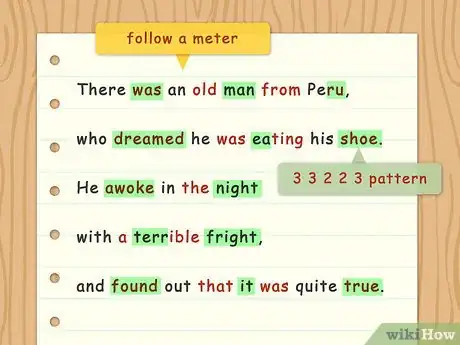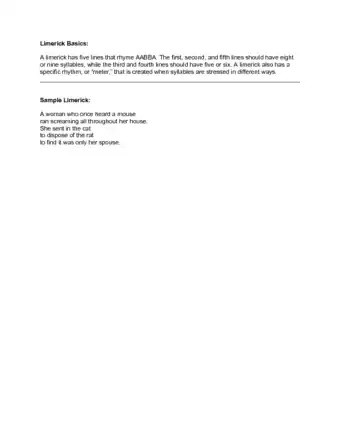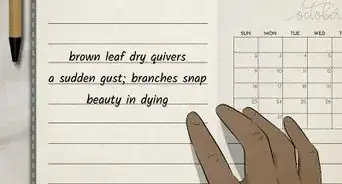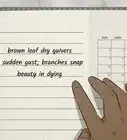This article was co-authored by Alicia Cook. Alicia Cook is a Professional Writer based in Newark, New Jersey. With over 12 years of experience, Alicia specializes in poetry and uses her platform to advocate for families affected by addiction and to fight for breaking the stigma against addiction and mental illness. She holds a BA in English and Journalism from Georgian Court University and an MBA from Saint Peter’s University. Alicia is a bestselling poet with Andrews McMeel Publishing and her work has been featured in numerous media outlets including the NY Post, CNN, USA Today, the HuffPost, the LA Times, American Songwriter Magazine, and Bustle. She was named by Teen Vogue as one of the 10 social media poets to know and her poetry mixtape, “Stuff I’ve Been Feeling Lately” was a finalist in the 2016 Goodreads Choice Awards.
There are 8 references cited in this article, which can be found at the bottom of the page.
wikiHow marks an article as reader-approved once it receives enough positive feedback. This article has 13 testimonials from our readers, earning it our reader-approved status.
This article has been viewed 703,877 times.
If you want to write a limerick
And do it really quick,
This wikiHow
Will show you how
To write a poem that sticks!
Limericks are whimsical 5-line poems with an AABBA rhyme structure that usually tell a funny story. They’re really easy (and fun) to write—your only limit is your imagination!
Steps
How to Master the Limerick Form
-
1Create an AABBA rhyme scheme. A limerick has five lines. The first, second, and fifth line should rhyme with each other. This is rhyme "A." To create rhyme "B," rhyme the third and fourth lines with each other. Rhyme "A" and "B" should be different from each other. The rhyme scheme will look like:[1]
- Line 1: Rhyme A
- Line 2: Rhyme A
- Line 3: Rhyme B
- Line 4: Rhyme B
- Line 5: Rhyme A
-
2Use a syllable scheme. In addition to rhyme, the poem should follow a syllable scheme where the first, second, and fifth lines have eight or nine syllables. The third and fourth lines will have five or six syllables. The syllable scheme will look like:[2]
- Line 1: Eight or nine syllables
- Line 2: Eight or nine syllables
- Line 3: Five or six syllables
- Line 4: Five or six syllables
- Line 5: Eight or nine syllables
Advertisement -
3Follow a meter. The meter of the limerick is the number of beats, or stressed syllables, in each line. A limerick will follow a meter that goes 3, 3, 2, 2, 3. You can also use "da" for unstressed syllables and “DUM” for stressed syllables. Say “da” and “DUM” aloud to yourself as you compose each line to make sure you are stressing the right words. The meter will look like:[3]
- Line 1: Three stressed syllables (da DUM da da DUM da da DUM)
- Line 2: Three stressed syllables (da DUM da da DUM da da DUM)
- Line 3: Two stressed syllables (da DUM da da DUM)
- Line 4: Two stressed syllables (da DUM da da DUM)
- Line 5: Three stressed syllables (da DUM da da DUM da da DUM)
How to Brainstorm Ideas
-
1Think of a funny or entertaining event. Limericks are often written about situations or moments that are silly and ridiculous. Think of an event or moment that made you laugh or giggle, recently or in the past.[4]
- For example, maybe you remember a funny event at a childhood birthday party that you can write about. Or perhaps you decide to write about an entertaining moment with your dog at the park earlier in the day.
-
2Use your name as the subject. Try brainstorming with a first line like, “There once was a girl named Sam” or “Once there was a fellow named Mark.” Then, think of absurd or silly things that can then happen to the subject of the poem.[5]
- For example, you may start with a premise like, “There once was a girl named Sam who fell into a pot of spam…”
-
3Focus on your city, town, or country in the poem. Focus on your hometown or somewhere you would like to travel to. Start with a line like “There once was a city named Yellowknife” or “There once was a country named Spain” and see where it takes you.[6]
-
4Use an interesting “what if” scenario. Make up a scenario that seems fantastical or silly, such as “What if cows could fly? Or “What if I became a bear?” Then, use the scenario as the set up for your limerick. Explore the scenario in the poem.
- For example, maybe you choose a scenario like “What if I became a bear?” and then explore how it might feel to walk, eat, and think like a bear in the limerick.
-
5Read examples of limericks. Look for classic and modern examples of limericks in poetry anthologies or online. Read the limericks out loud so you can get a sense of the rhythm and rhyme in the poems.[7] Find examples of limericks at http://www.webexhibits.org/poetry/explore_famous_limerick_examples.html.
How to Create a Draft of the Limerick
-
1Establish the main character in the first line. The first line of the limerick should let your readers know exactly who the poem is about. Include the character’s gender or name. You can start with a structure like “There once was” or “There was.” Make sure you follow the eight to nine syllable pattern for the first line.[8]
- For example, in a limerick by Edward Lear, the first line is: “There was an Old Person of Dover.”
- Another example is a limerick by Selina Wallis that begins with, “There once was a girl named Selina.”
-
2Use one syllable words that rhyme. Choose words that relate to your subject or main character. Pick words that are one syllable long to make it easier for you to follow the syllable count for each line as well.[9]
- For example, you may start with a first line like, “There once was a shy boy named Mark.” You may then think of words that rhyme with “Mark” like “shark,” “lark,” or “park.” You can then build a story around these rhyming words.
-
3Describe the main character doing something funny or strange. Use strong verbs that convey a sense of immediacy and action. Pick an action that might make your reader laugh or giggle.[10]
- For example, in the limerick by Edward Lear, the second line shows the old person from Dover doing something silly: “Who rushed through a field of blue Clover;”
- Another example is a limerick by an anonymous poet that opens with the lines: “A bather whose clothing was strewn/By winds that left her quite nude.”
-
4Give the main character an obstacle or issue to overcome. In the third and fourth line, the main character should be presented with a predicament that they must address. The obstacle could be another person or an animal. Maybe the main character falls or injures themselves. Pick an obstacle that might appear strange or a little ridiculous to the reader.
- For example, in the Lear limerick, the old person from Dover is confronted with an obstacle: “But some very large bees/Stung his nose and his knees.”
- In a limerick by Selina Wallis, the aspiring ballerina deals with an issue: “She went on her toes/And fell on her nose.”
-
5End with a realization or resolution. The last line of the limerick resolve the issue or obstacle for the main character. Maybe the main character has a sudden realization and makes a decision. Or perhaps the main character ends up doing something funny or ridiculous to get out of their predicament.[11]
- For example, the limerick by Edward Lear ends with the line: “So very soon he went back to Dover.” The poem is resolved when the old person realizes they needs to treat their bee stings and go back to their home.
- In the limerick by Selina Wallis, the ballerina realizes her injury means she cannot be dance anymore, and the last line is: “Then she became a cleaner.”
How to Polish the Limerick
-
1Read the limerick aloud. Emphasize the stressed syllables by saying the words louder when you read the poem aloud. You can also clap your hands on the stressed syllables in the limerick to make sure they are present in each line.[12]
- Make sure the limerick follows the proper rhyme scheme. Adjust it if the rhythm or rhyming is off.
- Check that there are no spelling, grammar, or punctuation errors in the limerick.
-
2Show the limerick to others. Get friends, peers, and family members to read your limerick and give you feedback. Ask them if they feel the limerick flows well and has the correct rhythm when read aloud. Notice if the limerick makes others laugh or giggle. This is a good sign it is successful.
- Be open to constructive feedback on the limerick from others.
-
3Title the limerick. Most poets will use the first line as the title of the poem, such as “There once was a man from Dover” or “There was a shy boy named Mark.” Place the title above the first line of the poem.
- You can also title the poem simply “Limerick” or the name of the main character, such as “Selina the Ballerina.”
Sample Limericks
Expert Q&A
Did you know you can get expert answers for this article?
Unlock expert answers by supporting wikiHow
-
QuestionWhat makes a good limerick?
 Alicia CookAlicia Cook is a Professional Writer based in Newark, New Jersey. With over 12 years of experience, Alicia specializes in poetry and uses her platform to advocate for families affected by addiction and to fight for breaking the stigma against addiction and mental illness. She holds a BA in English and Journalism from Georgian Court University and an MBA from Saint Peter’s University. Alicia is a bestselling poet with Andrews McMeel Publishing and her work has been featured in numerous media outlets including the NY Post, CNN, USA Today, the HuffPost, the LA Times, American Songwriter Magazine, and Bustle. She was named by Teen Vogue as one of the 10 social media poets to know and her poetry mixtape, “Stuff I’ve Been Feeling Lately” was a finalist in the 2016 Goodreads Choice Awards.
Alicia CookAlicia Cook is a Professional Writer based in Newark, New Jersey. With over 12 years of experience, Alicia specializes in poetry and uses her platform to advocate for families affected by addiction and to fight for breaking the stigma against addiction and mental illness. She holds a BA in English and Journalism from Georgian Court University and an MBA from Saint Peter’s University. Alicia is a bestselling poet with Andrews McMeel Publishing and her work has been featured in numerous media outlets including the NY Post, CNN, USA Today, the HuffPost, the LA Times, American Songwriter Magazine, and Bustle. She was named by Teen Vogue as one of the 10 social media poets to know and her poetry mixtape, “Stuff I’ve Been Feeling Lately” was a finalist in the 2016 Goodreads Choice Awards.
Professional Writer
-
QuestionHow is a limerick structured?
 Alicia CookAlicia Cook is a Professional Writer based in Newark, New Jersey. With over 12 years of experience, Alicia specializes in poetry and uses her platform to advocate for families affected by addiction and to fight for breaking the stigma against addiction and mental illness. She holds a BA in English and Journalism from Georgian Court University and an MBA from Saint Peter’s University. Alicia is a bestselling poet with Andrews McMeel Publishing and her work has been featured in numerous media outlets including the NY Post, CNN, USA Today, the HuffPost, the LA Times, American Songwriter Magazine, and Bustle. She was named by Teen Vogue as one of the 10 social media poets to know and her poetry mixtape, “Stuff I’ve Been Feeling Lately” was a finalist in the 2016 Goodreads Choice Awards.
Alicia CookAlicia Cook is a Professional Writer based in Newark, New Jersey. With over 12 years of experience, Alicia specializes in poetry and uses her platform to advocate for families affected by addiction and to fight for breaking the stigma against addiction and mental illness. She holds a BA in English and Journalism from Georgian Court University and an MBA from Saint Peter’s University. Alicia is a bestselling poet with Andrews McMeel Publishing and her work has been featured in numerous media outlets including the NY Post, CNN, USA Today, the HuffPost, the LA Times, American Songwriter Magazine, and Bustle. She was named by Teen Vogue as one of the 10 social media poets to know and her poetry mixtape, “Stuff I’ve Been Feeling Lately” was a finalist in the 2016 Goodreads Choice Awards.
Professional Writer
-
QuestionHow do I even find a rhyme for the word?
 Community AnswerSome dictionaries contain "rhyming dictionary" sections which will tell you, for instance, that "help" is one of the words likely to rhyme with the spelling "-elp".
Community AnswerSome dictionaries contain "rhyming dictionary" sections which will tell you, for instance, that "help" is one of the words likely to rhyme with the spelling "-elp".
References
- ↑ Alicia Cook. Professional Writer. Expert Interview. 11 December 2020.
- ↑ https://www.howmanysyllables.com/poetry/limerick_rules
- ↑ https://www.poetry4kids.com/lessons/how-to-write-a-limerick/
- ↑ Alicia Cook. Professional Writer. Expert Interview. 11 December 2020.
- ↑ https://www.poetry4kids.com/lessons/how-to-write-a-limerick/
- ↑ https://www.poetry4kids.com/lessons/how-to-write-a-limerick/
- ↑ https://parade.com/1249429/marynliles/limericks/
- ↑ http://www.powerpoetry.org/actions/5-tips-writing-limerick
- ↑ https://www.howmanysyllables.com/poetry/limerick_rules
About This Article
To write a limerick, come up with a 5-line poem where the first, second, and fifth line rhyme with each other and the third and fourth line rhyme with each other. Also, make sure the first, second, and fifth line have 8-9 syllables and the third and fourth line have 5-6 syllables. To see examples of limericks, keep reading!


















































































